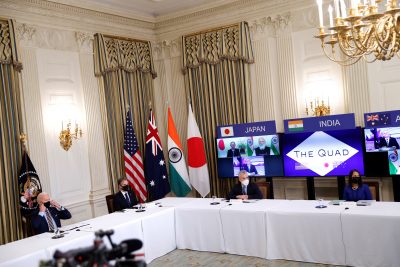n Friday, U.S. President Joe Biden will host Prime Ministers Narendra Modi of India, Scott Morrison of Australia and Yoshihide Suga of Japan at the White House for the first in-person Quad Summit.
They’ll focus on “deepening our ties and advancing practical cooperation” on Covid-19, the climate crisis, technology, cyberspace and “a free and open Indo-Pacific,” according to a White House statement.
As with just about every statement from the Quad, it makes no mention of China. But worries about China are at the root of the Quad. Since Xi Jinping became China’s leader in 2012, each of the four democracies has had serious run-ins with China on trade or territorial claims or both.
The “quadrilateral security dialogue” among Australia, India, Japan and the United States was once an informal, ongoing discussion between senior officials about naval cooperation. It’s morphing into top-level strategic cooperation on tech, the global economy, security and the pandemic.
China objects to the Quad as an attempt to derail its rise as a global power.
“Forming closed and exclusive ‘cliques’ targeting other countries runs counter to the trend of the times and deviates from the expectation of regional countries,” the country’s foreign ministry said last week in response to the White House meeting. “It thus wins no support and is doomed to fail.”
But even as it expresses confidence that the Quad will fail, Beijing takes aggressive actions that push the Quad countries closer together, according to several policy experts who spoke to CNBC.
“China is increasingly hemming itself in. Whatever objectives it might harbor for the Indo-Pacific, it’s getting in its own way,” said Ali Wyne, senior analyst for Global Macro at Eurasia Group.
To get a sense of what’s next, CNBC in February came up with a question — What is the future of the Quad? — and ran it through an advanced game theory model. The effort generated specific predictions about the four Quad nations, China and other countries and territories with a stake in the Indo-Pacific.
Game theory is an obscure concept to most people. In short, it tries to apply science to strategy. Game theorists construct models of situations involving competition between groups or individuals.
They then apply computing power to predict how individuals will interact in the model and what outcomes will be.
The use of game theory in CNBC’s Quad project comes as policymakers, investors and the risk-management industry are trying to get more quantitative rigor into their forecasts — in line with the rise of quantitative analysis across other sectors including trading and investing. Globally, algorithms are being relied upon to do more and more.
But game theory is not magic. It has limitations, which you can read more about here. Significantly, at least two of the policy analysts who helped build the model used for this report do not agree with some of the predictions it made.
But in the world of game theory, at least, the model implemented for this report is a well-regarded one. The methods developed by Bruce Bueno de Mesquita, of New York University and the Hoover Institution at Stanford University, were used by the CIA on more than 1,200 projects in the 1980s.
According to a declassified CIA report published by Yale University Press in 1995, Bueno de Mesquita’s former firm Policon had a 90% accuracy rate on predictions it made for the agency and generated greater detail than traditional analysis. Bueno de Mesquita claims a higher accuracy rate on projects undertaken for Fortune 500 clients since then.
Jonathan Grady, principal of start-up consulting firm The Canary Group and a protégé of Bueno de Mesquita, built the game theory model for this report. It was designed specifically to predict the Quad nations’ future together in maritime security.
In consultation with Bueno de Mesquita, Grady gathered input from 37 policy experts and former government officials. You can see a list of them here.
The model built for this report included almost 300 individual “players” — senior government officials and national institutions — spread among the Quad nations, China and 10 other countries and territories. CNBC’s Quad project is the largest computation ever run by the Bueno de Mesquita model in its history — more complex than any projects undertaken for the CIA or corporate clients.
What follow are the model’s predictions, and what political analysts say about them.
https://www.cnbc.com/quad-summit-and-china-game-theory-predictions-for-the-future-of-the-quad/





